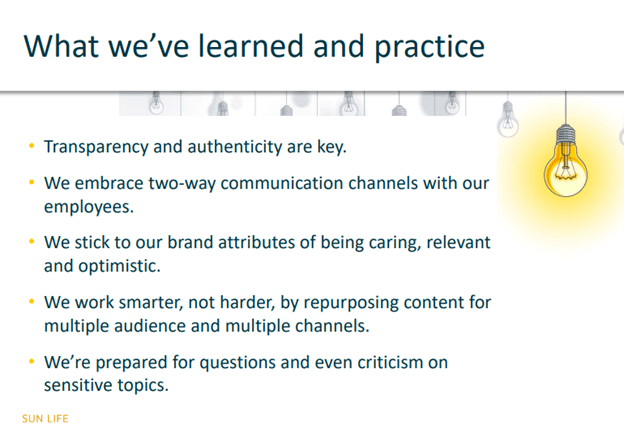5 lessons for more effective leadership comms
Creating a public platform for your top executives can rattle nerves, but finding that authentic voice for your organization has never been more important.
Making your leaders a more visible and empathetic face for your organization has become a top priority in the months since the global pandemic upended everything.
Audiences are looking for guidance and reassurance, someone who can show them how to get through the challenges ahead. They want to know that top leaders are taking them into consideration when making decisions and approaching the future of work and business with empathy.
PR pros are used to creating “thought leadership” for their clients and executives, but crafting that message has only become harder in our low trust environment.
In a recent session for Ragan Training titled “Creating Fresh Thought Leadership Content That Cuts Through the Noise,” Rachel Spates, associate director of communications for Sun Life shared five essential lessons for executive comms in today’s world.

Her list:
1. Transparency and authenticity are key. Your executive video doesn’t have to be “polished and professional,” as Spates puts it. It needs to be real and reflect the experiences of real people.
2. We embrace two-way communication channels with our employees. Tools like Workplace from Facebook have been a “game-changer,” says Spates. “We feel like we are not juts broadcasting out to our employees; we are having a conversation.”
The ability to field feedback in real time and adjust to the needs of employees or other audiences is essential, particularly in times of uncertainty.
3. We stick to our brand attributes. “Regardless of the channel, regardless of the person delivering the message, regardless of what the message is,” says Spates, its important to make sure that the message adheres to core values and beliefs.
4. Work smarter, not harder, by repurposing content for multiple channels. Spates gives examples, such as thinking about how internal and external messaging overlaps or finding content form a webinar that can be turned into a flier or a one-pager, blog post, etc.
5. We’re prepared for questions and criticism on sensitive topics. “You are going to have critics; you’re going to have naysayers,” says Spates. “And that’s OK.”
In an increasingly polarized environment, it’s not possible to please everyone and instead of trying to work backwards from criticism to find the least offensive posture, lean into core values and be prepared to weather critiques that you don’t agree with.
That said, Spates says it’s crucial to “have a strategy.” Being prepared can make all the difference in defending your position on an issue that you know will leave some in your audiences unhappy and looking to lash out.
What lessons have you taken from the past year in external communications, PR Daily readers?








Leaders made more visible may be more likely to get shot. Or sued. Also leaders who not only lead but try to be spokesmen are more likely than expert spokesmen to screw up an important communication. Just as a CEO who is not a professional baseball player is more likely to strike out, so is a CEO who is not a professional communicator.
Transparency isn’t always great either which is why we sometimes draw the shades in our homes and in our communications. But taking Ragan Training on executive communications is career-protective and speaker-protective because, when communication has to be by the Big Boss or a consigliere, Ragan Training can reduce the chances of your getting your speaker (or yourself) whacked.
The best time to learn how to avoid communication blunders is when an expert Ragan lecturer is teaching you, not when your speaker is up there speaking and you may learn the hard way.
The company should certainly pay your tuition because you are protecting your own neck but you are safeguarding an even more sensitive part of the corporate anatomy, what could be called a seat of learning.
Leaders made more visible may be more likely to get shot. Or sued. Also leaders who not only lead but try to be spokesmen are more likely than expert spokesmen to screw up an important communication. Just as a CEO who is not a professional baseball player is more likely to strike out, so is a CEO who is not a professional communicator.
Transparency isn’t always great either which is why we sometimes draw the shades in our homes and in our communications. But taking Ragan Training on executive communications is career-protective and speaker-protective because, when communication has to be by the Big Boss or a consigliere, Ragan Training can reduce the chances of your getting your speaker (or yourself) whacked.
The best time to learn how to avoid communication blunders is when an expert Ragan lecturer is teaching you, not when your speaker is up there speaking and you may learn the hard way.
The company should certainly pay your tuition because you are protecting your own neck but you are safeguarding an even more sensitive part of the corporate anatomy, what could be called a seat of learning.
Especially valuable in this expert’s excellent report is her fifth point
because (a) PR danger comes from questions and criticism, and (b) management executives are dazzled when PR turns a complaint into almost an endorsement.
An opportunity for success with point five is to make clear “we agree with you 100% that the problem you correctly cite is important, everyone may agree that it’s important to face this problem squarely, and there are of course several things that can be done successfully, not just one.”
This approach helps mollify the complainer that you seem to be (and are) agreeing, and a lot of steam goes out of a mollified complainer.
This approach also helps you to position what the company wants not as a disagreement but as an additional way to cope with the problem the complainer is complaining about. When you pitch what you want as an additional way not as an “instead of,” you may get much less opposition to what you want and—importantly—this doesn’t require you to endorse the complainer’s proposed answer.
This works again and again, and no one has to know because it doesn’t matter to complainers that you got the idea for this approach from Ragan reasoning.